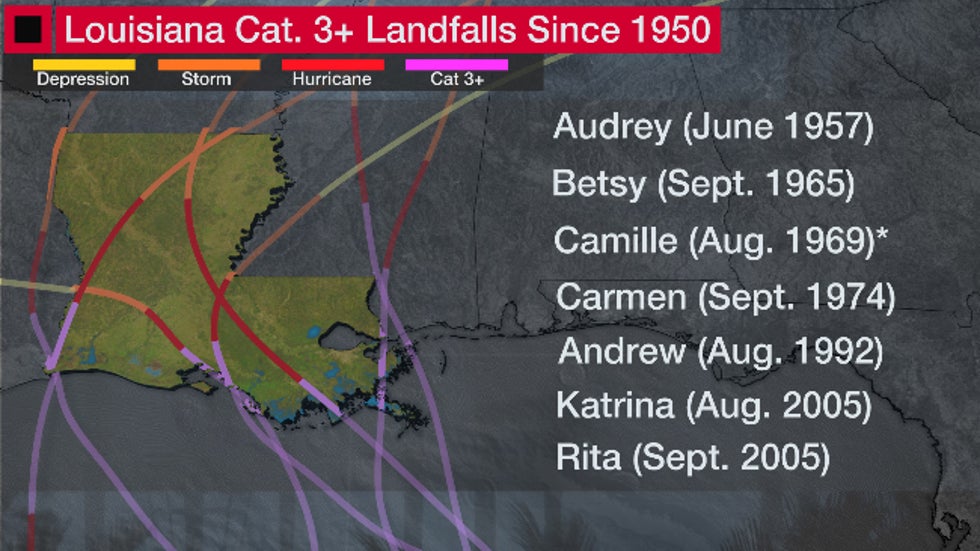Jonathan Erdman
This week, Laura could bring Louisiana its first landfall from a Category 3 or stronger hurricane in 15 years, since Hurricane Rita throttled parts of the state.
Laura has the potential to rapidly intensify over the Gulf of Mexico, possibly reaching Category 3 intensity before heading toward either the Texas or Louisiana coast.
Despite Louisiana's notorious hurricane history, a Category 3 or stronger hurricane hasn't made landfall in the Pelican State since Hurricane Rita pummeled southwestern Louisiana during the record-smashing 2005 Atlantic hurricane season.
At peak intensity, Rita was stronger than all but three other Atlantic Basin hurricanes, joining the elite sub-900 millibar minimum surface pressure club (minimum pressure: 895 millibars).
Responsible for an estimated $25.2 billion in damage, Rita fell just outside the top-10 costliest U.S. hurricanes list.
 In this satellite image from NOAA, Hurricane Rita is shown in the Gulf of Mexico heading toward the Texas coast on Sept. 23, 2005.
In this satellite image from NOAA, Hurricane Rita is shown in the Gulf of Mexico heading toward the Texas coast on Sept. 23, 2005.Despite that, Rita may have been one of the most forgotten hurricanes in recent history. Simply enter "Hurricane Rita forgotten" in a search engine, and you'll see many stories written about this storm.
How was this intense, destructive hurricane so overshadowed?
It Followed Katrina
Spinning up less than one month after Katrina ravaged Mississippi and southeastern Louisiana, national attention was still focused on how a 21st century U.S. hurricane, given today's forecast technology, could claim more than 1,500 lives.
Additional storm surge flooding during Rita in southeastern Louisiana prolonged the Katrina recovery. Therefore, it took until early October before all flood water was finally removed from New Orleans.
 Houses are seen in the flooded Lower Ninth Ward, Sept. 24, 2005, in New Orleans.
Houses are seen in the flooded Lower Ninth Ward, Sept. 24, 2005, in New Orleans.It Missed Houston
As Rita reached its peak intensity, America's fourth-largest city, Houston, was directly in the path, triggering a mass evacuation.
Rita's center, however, made landfall near the Sabine River – the border between the Texas and Louisiana coasts – sparing Houston but clobbering southwestern Louisiana and the Beaumont/Port Arthur, Texas, areas.
Nevertheless, according to a 2006 report from the Texas House of Representatives, an estimated 3.7 million residents evacuated from Corpus Christi to Beaumont in perhaps the largest evacuation in U.S. history at the time.
The ensuing gridlock left motorists stranded without gas, adequate food or restrooms, all during a triple-digit heat wave. The Texas House report cited up to 118 people might have died in the evacuation itself; Many may have evacuated unnecessarily.
 Vehicles jam the northbound lanes, right, of I-45 as the southbound lanes, left, are empty in Houston, Texas, Sept. 22, 2005, as people from south Texas evacuate in advance of Hurricane Rita.
Vehicles jam the northbound lanes, right, of I-45 as the southbound lanes, left, are empty in Houston, Texas, Sept. 22, 2005, as people from south Texas evacuate in advance of Hurricane Rita.Low 'Direct' Death Toll
Seven deaths, not from the evacuation, were directly related to Hurricane Rita.
For parts of southwestern Louisiana, Rita was every bit as bad as Katrina was for Mississippi and southeastern Louisiana.
Holly Beach, Cameron, Creole and Grand Cheniere were leveled by up to a 15-foot storm surge. Surge flooding extended as far north as Interstate 10 (about 25 miles inland), swamping Lake Charles, Louisiana, in up to 6 feet of water.
An 8- to 12-foot storm surge was estimated in parts of Vermillion, Iberia and St. Mary parishes, while a 3- to 5-foot surge inundated Port Arthur, Texas.
Rita also spawned 92 tornadoes from Sept. 23 to 25, according to Dr. Greg Forbes, then the severe weather expert for The Weather Channel.
 President George W. Bush flies over what was once a beach community in Cameron, Louisiana, on Sept. 27, 2005, during an aerial tour of the Louisiana and Texas areas affected by Hurricane Rita.
President George W. Bush flies over what was once a beach community in Cameron, Louisiana, on Sept. 27, 2005, during an aerial tour of the Louisiana and Texas areas affected by Hurricane Rita.Wilma Followed
Exactly one month later, Hurricane Wilma clobbered South Florida, including the Miami-Fort Lauderdale-West Palm Beach metro area, inflicting an estimated $25.8 billion in damage.
What's more, Wilma set a new Atlantic Basin pressure record – 882 millibars – while still in the western Caribbean Sea, 13 millibars lower than Rita's peak strength.
Louisiana Major Hurricanes Since 1950
Louisiana certainly has a notorious hurricane history, comprehensively documented by NOAA meteorologist and hurricane historian David Roth.
However, according to NOAA's hurricane database, only seven Category 3 or stronger hurricane landfalls have occurred in the state since 1950.
The list reads like a who's who of Louisiana's recent hurricane history: Katrina, Andrew's second landfall after pummeling South Florida, Camille, Betsy and Audrey.
 *While Camille's infamous landfall in 1969 was in Pass Christian, Mississippi, Camille's center did pass over a group of outer islands east of Lake Borgne at Category 5 intensity.
*While Camille's infamous landfall in 1969 was in Pass Christian, Mississippi, Camille's center did pass over a group of outer islands east of Lake Borgne at Category 5 intensity.The Weather Company’s primary journalistic mission is to report on breaking weather news, the environment and the importance of science to our lives. This story does not necessarily represent the position of our parent company, IBM.
The Weather Company’s primary journalistic mission is to report on breaking weather news, the environment and the importance of science to our lives. This story does not necessarily represent the position of our parent company, IBM.

No comments:
Post a Comment